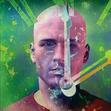Marty Halpern's Blog, page 31
July 12, 2013
Steven Utley's Silurian Tales
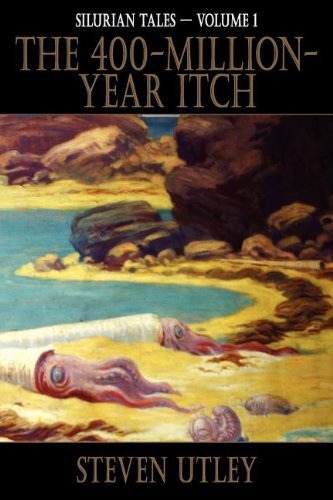 In the latter part of 2002, as an acquiring editor for Golden Gryphon Press, I was happily working away on a second collection of George Alec Effinger stories. To that end, I had contacted George's fellow writers, editors, and friends for their favorite GAE story (and once they named their favorite, I then cajoled and begged them into writing a brief introduction to said story for the collection). 1
In the latter part of 2002, as an acquiring editor for Golden Gryphon Press, I was happily working away on a second collection of George Alec Effinger stories. To that end, I had contacted George's fellow writers, editors, and friends for their favorite GAE story (and once they named their favorite, I then cajoled and begged them into writing a brief introduction to said story for the collection). 1Gardner Dozois was one of the editors whom I contacted, and he responded to my query via email on December 24, 2002. After recommending a number of Effinger stories in his email, including the pseudonymously written "O. Niemand" stories (which he did, in fact, introduce in the collection), Gardner wrote:
Cheeky as it may be of me, I've also been meaning to write to you and suggest two other worthy collections that are floating around out there and which don't seem to be able to find a home anywhere in the commercial publishing world.The first collection Gardner recommended was for "Avram Davidson's wonderful and as yet uncollected stories about Jack Limekiller, and his adventures in an imaginary but vividly detailed Central American country drenched with magic, strange creatures, and supernatural menaces." 2
As to the second collection, Gardner went on to write:
The other collection I'd like to recommend is Steven Utley's collection of Silurian Tales, which have been appearing in venues such as ASIMOV'S, F&SF, SCI FICTION, and elsewhere over the last decade or so. This probably will never appeal to the big trade publishers, since there are no dinosaurs in it, Steve somewhat perversely having decided to take us back in time to the Silurian Age rather than the dinosaur age, when the biggest things on land are segmented worms. But [the stories] have maintained a sustained level of brilliance all these years, with many of them making one or another Best of the Year collection, and I think a collection of them would make a worthy book.After the new year (2003), I tracked down a number of Steven Utley's Silurian Age stories in my copies of Asimov's SF and elsewhere, and was intrigued enough to contact the author. And a few months later Steven submitted a full collection of his Silurian tales.

At the time, Golden Gryphon Press was publishing eight hardcover titles per year, but unfortunately that level of production didn't last. Some months later I received an email from the publisher informing me that he wanted to reduce the number of books per year to a maximum of six titles. Given my current commitments, that meant my half of the schedule was already booked through the next two years. Consequently, were I to acquire the collection of Silurian tales, it wouldn't see publication for at least three years. I didn't feel that was right, to hold up the publication of Steven's collection for three years, when he might find another press who could publish the book sooner.
My rejection letter to Steven Utley is dated November 26, 2003, and concludes with the following paragraph:
If you’re up to it, I would be most grateful if you would keep me posted on your efforts to have the collection published. And, as I said, I would be pleased to put in a good word for the collection with another publisher, and explain why, given Golden Gryphon Press's current schedule, we're not publishing the book instead. In fact, I would like to know by whom and when the book will be published so that I may place an order myself for a copy!Steven did keep in touch, at least for a while; I recall receiving group emails from him with links to this and that, whatever he felt might be of interest to his contacts. At some point the emails stopped, and I never did hear anything further from him regarding the publication of his Silurian tales. (Though I will admit that I hadn't been actively searching for information either.) And then early this year, on January 12 -- or maybe it was the 13th that I actually read the news -- Steven Utley passed away.
Which, of course, brought to mind our communications back in 2003 regarding the collection, and its unfortunate rejection.
In the course of everyday business, I follow a number of writers', editors', and publishers' blogs and websites, one such being Jonathan Strahan's blog Notes from Coode Street. His May 17 blog post, bearing the title "Steven Utley's Invisible Kingdoms," certainly grabbed my attention. I clicked the entry in my Feedly RSS reader. Unbeknownst to me, Australian publisher Ticonderoga Publications -- whose first book in 1997 was Steven Utley's first collection, Ghost Seas
 -- had published not one volume, but two volumes of Silurian Tales: The 400-Million-Year Itch
-- had published not one volume, but two volumes of Silurian Tales: The 400-Million-Year Itch in 2012, and this year's Invisible Kingdoms
in 2012, and this year's Invisible Kingdoms . I was both surprised and saddened at the same time. Surprised to learn that the publication of these two books had completely escaped me, but saddened to realize that Steven wasn't alive to see the publication of the second volume. I immediately checked out the Ticonderoga Publications website for further details; and I was pleased to learn that Gardner Dozois, who had recommended the collection to me a decade ago, had written the introduction to volume 1. I then placed an order for both volumes (as I said that I would in that rejection letter) through Amazon.
. I was both surprised and saddened at the same time. Surprised to learn that the publication of these two books had completely escaped me, but saddened to realize that Steven wasn't alive to see the publication of the second volume. I immediately checked out the Ticonderoga Publications website for further details; and I was pleased to learn that Gardner Dozois, who had recommended the collection to me a decade ago, had written the introduction to volume 1. I then placed an order for both volumes (as I said that I would in that rejection letter) through Amazon.As Gardner Dozois notes at the beginning of his introduction, the first Silurian tale, "There and Then," was published in the November 1993 issue of Asimov's SF, and in the nineteen years since, nearly forty Silurian tales have been published across a wide range of both print and online venues. Gardner believes that Steven's Silurian tales may just be "one of the longest-running, continuously published series in modern science fiction."
And with the most kind permission of Gardner Dozois, here are some (albeit lengthy) excerpts from the introduction to The 400-Million-Year Itch. I hope that, as I did, you'll be adding at least one, if not both, of these volumes to your bookstore shopping cart.
The Silurian Tales take us through an experimental space/time warp generated by only partially understood high-tech means and deep into the prehistoric past, where, millions and millions of years ago, a scientific research station is established, the scientists eventually bringing a U.S. Navy destroyer through the warp to act as a floating center of operations. A classic time-travel scenario. Almost any other SF writer who ever lived, almost any other SF writer working today, given this scenario as a starting point, would have taken their protagonists back to the age of the dinosaurs. [Dinosaur] stories almost write themselves....
Instead, almost perversely, Steven Utley takes us and his protagonists back to the Silurian Age, "The Age of the Mud and Slime," in the title of one of his stories, one of the most boring of all prehistoric eras in terms of the possibilities for action-adventure stories it provides. No dinosaurs, which would not evolve until hundreds of millions of years later. No dinosaurs, in fact—no large, land-dwelling creatures of any kind, not even trees or bushes, as only the most primitive sorts of plant and animal life, mosses and fungi, and insects such as spiders and centipedes, had as yet colonized the land, spreading a thin border strip of life along the shores of oceans and streams and lakes. Inland, all else is desolate and barren. Brackish swamps, desert, bare rock, devoid of life of any kind. Even the sea, where the first bony fishes are just starting to develop, provides no monster worse than giant 2.5 meter-long sea scorpions....
Choosing such a landscape as the setting for time-travel stories is a move of breathtaking audacity, eliminating at a stroke most of the kinds of materials from which such stories are usually fashioned....
There's only the bleak landscape of the Silurian Age, and the peculiarities and paradoxes and intricate workings of time-travel itself, and, set against that plain, pure, desolate background, the characters, who are free to interact in the most subtle and movingly human of ways with little else to distract the reader from them.
Using only these limited means, like a boxer binding one arm behind his back before climbing into the ring, Utley has managed to produce some of the most complex, adult, and entertaining of modern science fiction stories....
If you haven't encountered the Silurian Tales before, I envy you the experience. If you have, you're probably already reading them, and not bothering with these words of mine at all.
Gardner DozoisSeptember 2012
---------------Footnotes
1. The GAE collection to which I refer is George Alec Effinger Live! From Planet Earth
 , which I wrote about extensively on May 12, 2009, and then reposted on January 12, 2013, in honor of GAE's 66th birthday. George Alec Effinger passed away in his sleep on April 27, 2002.
, which I wrote about extensively on May 12, 2009, and then reposted on January 12, 2013, in honor of GAE's 66th birthday. George Alec Effinger passed away in his sleep on April 27, 2002.2. Since the holidays were upon us at the time Gardner's email arrived, I didn't begin to pursue his two collection suggestions until after the New Year. I quickly learned that Henry Wessells and the Avram Davidson Society were already hard at work on a Limekiller
 collection, which was published later that year by Old Earth Books. (And I do, in fact, have a copy of Limekiller in my library.)
collection, which was published later that year by Old Earth Books. (And I do, in fact, have a copy of Limekiller in my library.)
Published on July 12, 2013 16:09
July 10, 2013
Editors/Agents: What would you like writers to stop doing?
 Over the July 4th holiday weekend, I attended Westercon 66 at the Hilton Arden West Hotel in Sacramento. I participated in three group panels, and one solo panel, which is the primary focus of this blog post.
Over the July 4th holiday weekend, I attended Westercon 66 at the Hilton Arden West Hotel in Sacramento. I participated in three group panels, and one solo panel, which is the primary focus of this blog post.First, just for the sake of posterity, I'd like to list the three group panels on which I participated, with a special nod to my fellow panelists who helped make the respective panels enjoyable as well as educational (for me as well as the audience).
July 5, 11:15:00, Sonoma conference roomThe Pain & Joy of Self PublishingSelf-publishing allows the author to retain total creative control, but means they forgo the benefits of being with a major label. Our panel discusses the benefits and drawbacks of self-publishing and how to compensate for not having an editor and publishing house.Panelists: M. Todd Gallowglas (M); Valerie Frankel; Marty Halpern; Emerian Rich; Karen Sandler; Jean Marie Stine.So these were the three group panels in which I participated. I've been on a number of similar panels over the course of the past few years, at Baycon, Fogcon, Convolution, and Westercon, but since the industry -- and technology -- change so rapidly, and the panelists differ from con to con, there is always an opportunity for the audience (and me as well) to learn something new or, at least, to learn how the industry has changed.
July 6, 11:15:00, Sonoma conference roomSecrets of PublishingNearly every SF/fantasy author has been published by a smaller press at some point in their careers. It is also known for publishing new authors, midlist authors, short story collections, and other "odd" books typically rejected by the big New York publishers. Our panelists represent a spectrum of publications, and can "tellall."Panelists: David Maxine (M); Marty Halpern; Jacob Weisman.
[Note: I was under the impression that the "tell all" part of this panel was for the panelists to share some of their "publishing secrets" with the audience. Unfortunately, though I had come prepared with plenty of secrets, this was not the case. Instead, the discussion concerned copyright, distribution, etc. -- and I left with all of my "secrets" intact. Maybe next time....]
July 6, 12:30:00, Folsom conference roomPublishing Options: Traditional vs On-Demand and Self-PublishingThe days of needing your own printing press are long gone. With modern publishing methods you can print one copy or 1 million. Our panelists will discuss the benefits and drawbacks of the various publishing options.Panelists: Ben Yalow (M); Kelley Eskridge; Marty Halpern; Phyllis Kalbach; Emerian Rich; Jean Marie Stine.
And here are the details for my solo panel:
July 6, 3:00:00 Merlot conference roomAsk The EditorJoin Marty Halpern for "Ask the Editor." Bring your general editing questions or specific editing questions. You may also bring a copy of your own work for demo editing.Marty Halpern (M)Fortunately, no one in the audience had brought manuscript pages to be demo-edited; I say "fortunately" because the projection system and flip chart that Westercon programming had promised to provide me were never delivered (which, in my overall experience at a number of Bay Area cons in recent years, is fairly typical; if you really need a projection system, flip chart, etc., bring your own).
Following my lengthy introduction and some general chatting with the audience, I asked for questions -- and Effie Seiberg posed the following: "What would you like writers to start doing?" and "What would like writers to stop doing?"
These were actually very good questions, and the first part -- What I would like writers to start doing -- was easily answered: spell check your work! I'm not talking about spelling errors like "their," "they're," and "there." I'm talking about blatant spelling errors that even Microsoft's lousy spell checker would catch. Not to spell check your work is, in my humble editorial opinion, nothing but pure laziness. Blatant spelling errors in a manuscript will easily turn off a potential agent, editor, or publisher, because it shows a lack of respect for your own work (and their time).
Of course, once I had given the "spell check" response, a second thought immediately came to mind: style sheet. I've previously written about style sheets in December 2010, in February 2011, and again in January 2012. As I've mentioned at least once in those three blog posts, in my near fifteen years as an editor, only two authors have ever provided me with a style sheet: Michael A. Stackpole and Mark Teppo. Style sheets should become a matter of habit for every author, for novels especially, but for short stories, too. I would argue that a detailed style sheet will eliminate a number of questions and mark-ups on the author's manuscript, thus making the editor's job easier and, in turn, the author's job when the manuscript is returned.
As to the second half of Effie's question: What would I like writers to stop doing? -- though I thought for a brief moment, nothing really came to mind then -- and nothing has come to mind since. I'm not a stickler for formatting guidelines, or grammar rules, as long as the author is consistent throughout the manuscript. So I guess I could add a third point to the "What I would like writers to start doing": be consistent.
Which brings me to the audience participation part of this blog post: If you are an agent, an editor, and/or a publisher, what would you like writers to stop doing?

Published on July 10, 2013 17:04
July 1, 2013
Google Reader: October 2005 to July 2013
Published on July 01, 2013 11:43
June 25, 2013
Wattsworld: Peter Watts and Beyond the Rift
I'm quite a cheerful guy in person. Apparently people are surprised by this.
I don't know what they were expecting....But insofar as I'm known at all, I seem to be known as The Guy Who Writes The Depressing Stories....While mulling over what to put in this essay I did a quick Google search for the descriptors commonly applied to my writing. I list a few for illustrative purposes:
Brutal
Dark (frequently "unrelentingly" so)
Paranoid
Nightmarish
Relentless
The blackest depths of the human psyche
Ugly
Savage
Misanthropic
Dystopian
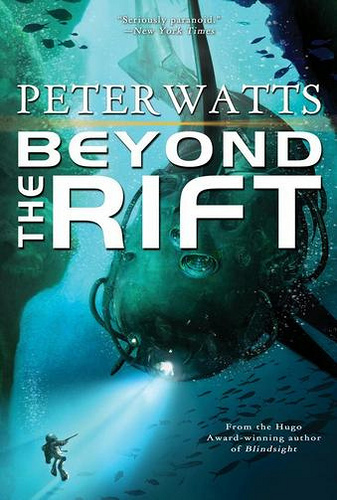
Cover art by Hugh Sicotte
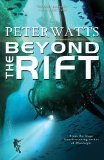 So writes Peter Watts, in the afterword, entitled "Outtro: En Route to Dystopia with the Angry Optimist," to his forthcoming short story collection,
Beyond the Rift
So writes Peter Watts, in the afterword, entitled "Outtro: En Route to Dystopia with the Angry Optimist," to his forthcoming short story collection,
Beyond the Rift
 .
. As to Peter's opening sentence above, often readers confuse the writer with their writing. Though authors often call upon personal experiences in their writing, it certainly doesn't mean that the writer him/herself is in any way the protagonist in their stories. That's why these stories are called fiction.
If you've not previously read the works of Canadian science fiction writer Peter Watts, then indeed you are in for a treat.
Take, for example, the story "The Things," an homage to the classic science fiction movie, told from the creature's point of view. Then there is the story "The Island," in which a mother and son and an AI called "Chimp," aboard the generation ship Eriophora, must deal with a close encounter in the far reaches of space. "The Things" (originally published in Clarkesworld #40, January 2010) won the Shirley Jackson Award for best short story, and "The Island" (originally published in The New Space Opera 2, edited by Gardner Dozois & Jonathan Strahan, HarperCollins) won the Hugo Award for best novelette. In fact, Watts's stories and novels have been nominated for numerous awards, including the Hugo Award, the Theodore Sturgeon Award, the Campbell Award, the Locus Award, and the BSFA Award, among others -- and some of these awards more than once.
Beyond the Rift was my most recent project for publisher Tachyon Publications -- a copy editing job that I had been looking forward to since I first learned of the project earlier this year.
Watts's stories are all so well written that it is difficult to pick a favorite story. I think my favorite is "A Niche" (originally published in Tesseracts 3, edited by Candas Jane Dorsey & Gerry Truscott, Porcépic Books) because, well, because we all need our own space, our own personal niche -- even if it just happens to be below three kilometers of ocean; and we're all a little bit weird in our own unique way, aren't we? But then again, if you asked me next week what my favorite story is I could very well select a different one: maybe "Ambassador" (originally published in Ten Monkeys, Ten Minutes, EDGE Science Fiction and Fantasy Publishing), which is sort of like the car chase in The French Connection but with spaceships jumping across interstellar space.
In "Outtro," we also learn a bit about Peter Watts the person. He shares with us his run in, in December 2009, with U.S. border guards at the U.S.-Canadian border, upon returning home from a visit with friends in Nebraska. The outcome -- which prohibits Peter from ever again entering the United States -- most certainly contributes to his dystopian outlook in his writing.
You can read "The Things" online courtesy of Clarkesworld Magazine . After which, I hope you'll be adding Beyond the Rift
 to your online shopping cart. The book will be published on November 1.
to your online shopping cart. The book will be published on November 1.
Published on June 25, 2013 15:10
June 10, 2013
Weird Solutions to the Fermi Paradox
 Back in 2010, my co-edited (with Nick Gevers) anthology
Is Anybody Out There?
Back in 2010, my co-edited (with Nick Gevers) anthology
Is Anybody Out There?
 was published by DAW Books: stories each with a unique take on the Fermi paradox. And just what is the Fermi paradox, you may ask? Here's an excerpt from our pitch for the book:
was published by DAW Books: stories each with a unique take on the Fermi paradox. And just what is the Fermi paradox, you may ask? Here's an excerpt from our pitch for the book:Why is it that, in such a vast cosmos, with hundreds of billions of stars in this galaxy alone, and no doubt billions of Earth-like planets orbiting them, we have found no evidence of intelligent alien life? No evidence that aliens have ever visited Earth (other than discredited UFO mythology), no detectable signals in all our SETI searches with radio telescopes...
So it was with great interest that I happened upon an article on io9.com entitled "11 of the Weirdest Solutions to the Fermi Paradox." Though, when you think about them, they're not so weird after all -- especially in comparison to some of the stories in Is Anybody Out There?
I'll list the eleven points, with a very brief explanation; you'll need to read the io9 article, which I heartily recommend, for the details:
1. The Zoo Hypothesis: we're stuck inside some kind of celestial cage, and we're being watched.
2. Self-Imposed Quarantine: Extra-Terrestrial Intelligences (ETIs) may have collectively and independently decided to stay at home and not draw attention to themselves.
3. The Whack-a-Mole Hypothesis: ETIs are hovering over us with a giant hammer ready to smack it down should they suddenly not like what they see. Sort of like the Zoo Hypothesis, but not as friendly.
4. We're Made Out of Meat: Yum! Reminds me of The Twilight Zone episode "To Serve Man" (based on the story of the same name by Damon Knight).
5. The Simulation Hypothesis: were living inside a computer simulation — and the simulation isn't generating any extraterrestrial companions for us.
6. Radio Silence: it's possible that ETIs are listening, but no one is transmitting.
7. All Aliens Are Homebodies: an advanced enough ETI could lose all galactic-scale ambitions.
8. We Can't Read the Signs: it's totally possible that the signs of ETIs are all around us, but we just can't see/understand/detect them.
9. They're All Hanging Out At the Edge of the Galaxy: we’re looking for ET in the wrong place — they've set up camp where it's super cool, at the outer rim of the Galaxy.
10. Directed Panspermia: we haven’t made contact with ETIs because we're the aliens, or at least, they're our ancestors.
11. The Phase Transition Hypothesis: the universe is still evolving and changing, and the conditions to support advanced intelligence have only recently fallen into place.
Most of these "weird" solutions, or theories, however, are nothing compared to what you will find in Is Anybody Out There? How about an alien that appears only once a year, and only visible at a certain time and place, because the alien is out of phase with our own reality? ("The Dark Man" by Kristine Kathryn Rusch) Or aliens who try to communicate via the hypertext in an online library database? ("Graffiti in the Library of Babel" by David Langford) Or, a dying astronaut, who insists he made alien contact during his time in space, but no one believes him -- well, maybe one does. ("Where Two or Three" by Sheila Finch) Aliens are among us, residing in the human brain. ("The Taste of Night" by Pat Cadigan)
These are just a taste (no pun intended) of the fifteen stories included in Is Anybody Out There? which has obviously sold well enough to justify a second printing -- not too shabby in the world of mass market paperback anthologies. I have a dedicated IAOT? page with links to all the blog posts, including the complete text to a half-dozen of the stories, including the four mentioned above.

Published on June 10, 2013 13:39
June 6, 2013
Skyhorse Publishing and Start Media Acquire Night Shade Books
FOR IMMEDIATE RELEASE
CONTACT:
Oleg Lyubner
olyubner@skyhorsepublishing.com
Meghan Kilduff
kilduff@start-media.com
SKYHORSE AND START ACQUIRE NIGHT SHADE BOOKS
(June 3, 2013) Skyhorse Publishing, Inc. and Start Publishing are pleased to announce the acquisition of Night Shade Books, an award-winning independent publishing house dedicated to science fiction, fantasy, and horror.
Founded by Jason Williams in 1997, who was joined by partner Jeremy Lassen shortly after, Night Shade Books has over 250 titles in its catalog, including some renowned genre fiction—written by multiple nominees and winners of Shirley Jackson, Bram Stoker, World Fantasy, Nebula, and Hugo awards. In 2003, Night Shade Books won the World Fantasy Special Award for Professional Achievement. Both Williams and Lassen will continue to be with Night Shade in a consulting capacity.
THE AGREEMENT WAS REACHED FOLLOWING A SPIRITED AND PUBLIC DEBATE AMONG AUTHORS, AGENTS, FANS, AND PUBLISHERS, WHICH RESULTED IN A DEAL APPROVED BY NIGHT SHADE’S AUTHORS. “THIS AGREEMENT BRINGS TOGETHER NIGHT SHADE’S DISTINCTIVE EDITORIAL VOICE AND SKYHORSE’S BUSINESS SAVVY AND MARKET REACH, FOR THE BENEFIT OF ALL INVOLVED, INCLUDING AUTHORS AND THE GREAT COMMUNITY OF SF/F FANS,” SAYS MICHAEL J. MARTINEZ, AUTHOR OF THE DAEDALUS INCIDENT, SLATED TO BE THE FIRST TITLE FROM THE NEW NIGHT SHADE. “I’M HONORED THAT MY FIRST BOOK WILL HELP KICK OFF THE NEXT CHAPTER IN NIGHT SHADE’S ONGOING STORY.”
“We’re absolutely thrilled to have added Night Shade to our various other imprints and look forward to working with Start Publishing to build it into the strong science fiction imprint that we feel confident it can become,” said Tony Lyons, Publisher of Skyhorse Publishing, Inc.
“Nightshade has been at the forefront of science fiction and fantasy for years. Start Publishing, alongside Skyhorse Publishing, welcomes the opportunity to provide Night Shade and its authors a platform to continue that tradition,” added Michael Maher, CEO of Start Media.
“I am very excited to have found a buyer that is such a good fit for Night Shade, one that will be able to take us further than I was able to on my own. I look forward to building up Night Shade into the powerhouse of science fiction and fantasy for years to come,” said Night Shade founder Jason Williams. Night Shade had net sales of roughly $1.5 million for the 2012 calendar year.
If you have any questions, please do not hesitate to contact Oleg Lyubner, Director of Publicity at Skyhorse Publishing, and Meghan Kilduff at Start Publishing.
Publicity Contacts
Oleg Lyubner / (212) 643-6816 x 229 / olyubner@skyhorsepublishing.com
Meghan Kilduff / (212) 431-5455 / kilduff@start-media.com
Skyhorse Publishing, Inc.
307 West 36th Street, 11th Floor
New York, NY 10018
(212) 643-6816
www.skyhorsepublishing.com

CONTACT:
Oleg Lyubner
olyubner@skyhorsepublishing.com
Meghan Kilduff
kilduff@start-media.com
SKYHORSE AND START ACQUIRE NIGHT SHADE BOOKS
(June 3, 2013) Skyhorse Publishing, Inc. and Start Publishing are pleased to announce the acquisition of Night Shade Books, an award-winning independent publishing house dedicated to science fiction, fantasy, and horror.
Founded by Jason Williams in 1997, who was joined by partner Jeremy Lassen shortly after, Night Shade Books has over 250 titles in its catalog, including some renowned genre fiction—written by multiple nominees and winners of Shirley Jackson, Bram Stoker, World Fantasy, Nebula, and Hugo awards. In 2003, Night Shade Books won the World Fantasy Special Award for Professional Achievement. Both Williams and Lassen will continue to be with Night Shade in a consulting capacity.
THE AGREEMENT WAS REACHED FOLLOWING A SPIRITED AND PUBLIC DEBATE AMONG AUTHORS, AGENTS, FANS, AND PUBLISHERS, WHICH RESULTED IN A DEAL APPROVED BY NIGHT SHADE’S AUTHORS. “THIS AGREEMENT BRINGS TOGETHER NIGHT SHADE’S DISTINCTIVE EDITORIAL VOICE AND SKYHORSE’S BUSINESS SAVVY AND MARKET REACH, FOR THE BENEFIT OF ALL INVOLVED, INCLUDING AUTHORS AND THE GREAT COMMUNITY OF SF/F FANS,” SAYS MICHAEL J. MARTINEZ, AUTHOR OF THE DAEDALUS INCIDENT, SLATED TO BE THE FIRST TITLE FROM THE NEW NIGHT SHADE. “I’M HONORED THAT MY FIRST BOOK WILL HELP KICK OFF THE NEXT CHAPTER IN NIGHT SHADE’S ONGOING STORY.”
“We’re absolutely thrilled to have added Night Shade to our various other imprints and look forward to working with Start Publishing to build it into the strong science fiction imprint that we feel confident it can become,” said Tony Lyons, Publisher of Skyhorse Publishing, Inc.
“Nightshade has been at the forefront of science fiction and fantasy for years. Start Publishing, alongside Skyhorse Publishing, welcomes the opportunity to provide Night Shade and its authors a platform to continue that tradition,” added Michael Maher, CEO of Start Media.
“I am very excited to have found a buyer that is such a good fit for Night Shade, one that will be able to take us further than I was able to on my own. I look forward to building up Night Shade into the powerhouse of science fiction and fantasy for years to come,” said Night Shade founder Jason Williams. Night Shade had net sales of roughly $1.5 million for the 2012 calendar year.
If you have any questions, please do not hesitate to contact Oleg Lyubner, Director of Publicity at Skyhorse Publishing, and Meghan Kilduff at Start Publishing.
Publicity Contacts
Oleg Lyubner / (212) 643-6816 x 229 / olyubner@skyhorsepublishing.com
Meghan Kilduff / (212) 431-5455 / kilduff@start-media.com
Skyhorse Publishing, Inc.
307 West 36th Street, 11th Floor
New York, NY 10018
(212) 643-6816
www.skyhorsepublishing.com

Published on June 06, 2013 17:05
June 5, 2013
Ross E. Lockhart's Word Horde and Tales of Jack the Ripper
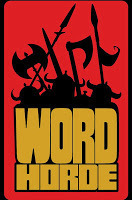
In the past few weeks I've worked on three projects by former Night Shade Books assets. "Assets" -- don't you just love that word? It's so wonderful when the publishing industry refers to its authors -- people -- human beings! -- as assets. I tend to think of assets as material objects: company cars, machinery, inventory -- property; but not people. And maybe, just maybe, that's why the traditional book publishing business is in the asset hole that it currently finds itself, as more and more assets -- people -- leave traditional publishing to self-publish and/or set up their own micro presses.
The first of the three projects was Bradley P. Beaulieu's self-published short fiction collection, Lest Our Passage Be Forgotten & Other Stories
 , which I blogged about here; and the second project is the forthcoming collection of Company stories,
In the Company of Thieves
, which I blogged about here; and the second project is the forthcoming collection of Company stories,
In the Company of Thieves
 , by Kage Baker and Kathleen Bartholomew, from Tachyon Publications -- which I blogged about here.
, by Kage Baker and Kathleen Bartholomew, from Tachyon Publications -- which I blogged about here.Which brings me to my most recent project:
There is a new publisher in town, virtually speaking, that is: Word Horde press.
After serving five years as the anchor that centered and steadied the inevitable tsunami-bound ship that was Night Shade Books, Ross E. Lockhart formed his own publishing venture earlier this year, and thus we have Word Horde.
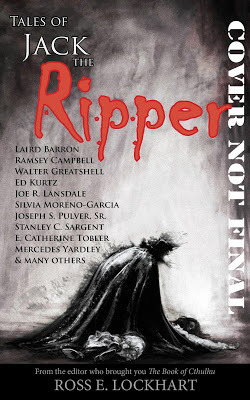
Cover art by Arnaud de Vallois
While at Night Shade, Ross edited the two epic Lovecraftian anthologies -- The Book of Cthulhu
 and
The Book of Cthulhu II
and
The Book of Cthulhu II
 . Now, with the launch of Word Horde, Ross's first book -- the enthralling Tales of Jack the Ripper -- affirms the Ripper's Whitechapel slayings in 1888, 125 years ago.
. Now, with the launch of Word Horde, Ross's first book -- the enthralling Tales of Jack the Ripper -- affirms the Ripper's Whitechapel slayings in 1888, 125 years ago.You can read the official Press Release, which includes a complete list of the contents of the anthology, but let me take this opportunity to excerpt just a paragraph from that PR:
The story of Jack the Ripper captured lurid headlines and the public's imagination, and the first fictionalization of the Ripper killings, John Francis Brewer's The Curse Upon Mitre Square appeared in October of 1888, mere weeks after the discovery of Jack's first victim. Since then, hundreds of stories have been written about Bloody Jack, his victims, and his legacy. Authors ranging from Marie Belloc Lowndes to Robert Bloch to Harlan Ellison to Roger Zelazny to Alan Moore have added their own tales to the Ripper myth. Now, as we arrive at the quasquicentennial of the murders, we bring you a few tales more.
Of the seventeen stories (and two bookending poems by Ann K. Schwader) included in this volume, fourteen of them are original to the anthology. (Again, check the official PR for a list of the contents.) The three reprint stories are by a few authors you may even recognize: Ramsey Campbell, Alan M. Clark and Gary A. Braunbeck, and Joe R. Lansdale.
Every themed anthology faces the issue of repetitive content: Can the editor -- and the contributing authors -- maintain the reader's interest/attention through fifteen or twenty or more stories without yielding to theme overload? After reading (and copy editing) Tales of Jack the Ripper this past week, I believe this anthology successfully (and I use that word with emphasis) responds to this issue. While reading these stories I found myself amidst the offal and stink of the back alleys of 1888 Whitechapel; questioning who the Ripper really was (a female assailant?); tracking how the "Ripper disorder" skipped generations to present day; and more.
It's probably best not to read the stories in Tales of Jack the Ripper at night -- and alone.

Published on June 05, 2013 15:11
May 29, 2013
Jack Vance 1916–2013
Today we lost one of the greats: Jack Vance -- a Grand Master of science fiction; or maybe his style of writing would be better served were I to call it "science fantasy." Jack Vance was 96 years young, with a lifetime of experiences that ranged the entire world.
In memory of Jack Vance, I would like to post the following, which I originally published on this blog on July 31, 2009: I recount my two visits to the Vance household in the Oakland foothills, in 1989 and 1990; I also hold Jack Vance responsible for my book collecting addiction....
At Home with Jack Vance
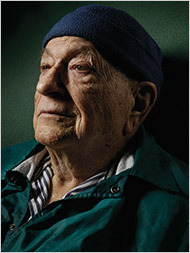 At 92 years of age (soon to be 93, on August 28), author Jack Vance is finally garnering some long-overdue, well-deserved attention in the media. And considering that he hasn't published any new fiction since 2004 (novel Lurulu, sequel to Ports of Call, 1998; both from Tor Books), this is indeed a remarkable accomplishment. Why all the media attention now? Because Vance has two books that have just been published by Subterranean Press. First and foremost is Vance's autobiography,
This Is Me, Jack Vance!
At 92 years of age (soon to be 93, on August 28), author Jack Vance is finally garnering some long-overdue, well-deserved attention in the media. And considering that he hasn't published any new fiction since 2004 (novel Lurulu, sequel to Ports of Call, 1998; both from Tor Books), this is indeed a remarkable accomplishment. Why all the media attention now? Because Vance has two books that have just been published by Subterranean Press. First and foremost is Vance's autobiography,
This Is Me, Jack Vance!
 (more on this in a bit). The second title is anthology
Songs of the Dying Earth
(more on this in a bit). The second title is anthology
Songs of the Dying Earth
 , which is subtitled "Stories in Honor of Jack Vance." Songs features some of the best writers in the genre: Neil Gaiman, George R. R. Martin (who co-edited the anthology), Lucius Shepard, and Dan Simmons, to name only four, with an appreciation by Dean Koontz. What makes this book even more special is that Vance himself has written a new preface to open the anthology.
, which is subtitled "Stories in Honor of Jack Vance." Songs features some of the best writers in the genre: Neil Gaiman, George R. R. Martin (who co-edited the anthology), Lucius Shepard, and Dan Simmons, to name only four, with an appreciation by Dean Koontz. What makes this book even more special is that Vance himself has written a new preface to open the anthology.
Carlo Rotella, director of American Studies at Boston College, wrote an excellent and lengthy piece (nearly 3,700 words) on Jack Vance entitled "The Genre Artist" in the July 15 New York Times. Rotella's introduction to Vance's fiction occurred when he was 14 years old, and he's been reading the author's work ever since. In this article Rotella quotes from a number of Vance novels, quotes from contributors (Tanith Lee and Dan Simmons) to the Songs anthology, and even quotes from Pulitzer Prize-winning novelist Michael Chabon: "Jack Vance is the most painful case of all the writers I love who I feel don't get the credit they deserve. If 'The Last Castle' or 'The Dragon Masters' had the name Italo Calvino on it, or just a foreign name, it would be received as a profound meditation, but because he's Jack Vance and published in Amazing Whatever, there's this insurmountable barrier." Well said, Mr. Chabon! I'm awaiting my copy of This Is Me, Jack Vance! from Subterranean Press, but in the meantime I have Rotella's article to tide me over. By the way, Rotella notes that "Vance takes pride in his craft but does not care to talk about it in any detail, going so far in his memoir as to consign almost all discussion of writing to a brief chapter at the end." If you're not familiar with Jack Vance, this article is a great mini-introduction to Vance's work, and his life. Kudos to Carlo Rotella.
I personally lay all the blame for my rampant book collecting on Jack Vance... Well, that's not really fair: his mass market paperback publishers Berkley Medallion and DAW Books actually share that dubious honor. I was already an avid book reader, but it was Jack Vance's Demon Princes series that drove me to my bibliophilic behavior. I don't recall how the Demon Princes series was brought to my attention, but in the early '80s I made a concerted effort to track down these five books. Now, you have to remember that at that point in time, there was no internet; there was no "online" in which to do an online book search. In those days we actually had to visit bookstores; and we used the telephone and, dare I say it, book catalogs sent through the mail to acquire specific titles. My favorite bookstore was Books, Inc. in the Town & Country shopping center near the corner of Stevens Creek and Winchester boulevards in San Jose. Books, Inc. closed down not too long after the Barnes and Noble superstore opened about a block away; and now the entire Town & Country shopping center is gone, replaced by the upscale Santana Row. But back to Books, Inc.: The store was a panacea for SF readers in particular because the management never returned a book. Regardless of the number of copies they ordered of any particular paperback, those copies would remain on the shelves until they sold. You could find paperbacks on the shelves that were years old, the pages often yellowed from age. So that's where I went to purchase the five volumes in Vance's Demon Princes series. The first three books in the series -- Star King, The Killing Machine, and The Palace of Love -- were published in the '60s by Berkley Medallion; the final two books in the series -- The Face and The Book of Dreams -- were published by DAW Books in 1979 and 1981 respectively. Unfortunately, I only found one of the DAW books on the shelf. A clerk assisted me by looking up the other four titles in Books in Print (available as a set of humongous hardcovers as well as on microfiche). It turned out that two of the five titles were out of print -- one from Berkley Medallion and the first book from DAW. And, not understanding the stupidity of publishers at the time, I couldn't comprehend why any publisher would allow the middle books of a five-book series to go out of print. It just didn't make any sense to me -- then. But in the course of looking through Books in Print, the clerk discovered that the series had been published in a hardcover edition by an independent press called Underwood-Miller. Great, I said, let's order them. Sorry, said the clerk, we don't deal directly with that publisher, and those titles aren't available through our regular distributor. Sigh... Time to go home and make some telephone calls to other bookstores in the area.
This is how I discovered genre bookstore Future Fantasy in Palo Alto, about a 25-mile drive from where I live. I telephoned the store, and yes, they could order the books for me, but I would have to pay for them in advance. So I made the drive to Palo Alto, only to discover that the store proprietor would only order one volume at a time -- even though I was willing to pay for the five books all at once, up front. Not sure of her rationale; but keep in mind that this was the early '80s and each of these trade hardcovers cost, I believe it was, $20.00 each -- so the set of five books was $100.00 (plus tax). Anyhow, I paid for the first book in advance, returned to the store a couple weeks later when the book arrived and paid in advance for the next one in the series, and so on until I owned all five books. Of course, I was now hooked on hardcovers and limited editions, having been in Future Fantasy -- browsing and buying -- six times over the span of about three months: the road to ruin, you might say. Future Fantasy moved a few years later to a larger store, but then the local competition and the internet finally took its toll and the store closed as well.
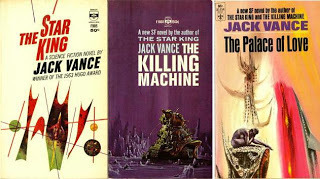
The Berkley Medallion paperbacks
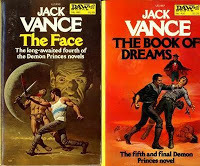
The DAW paperbacks
However, I eventually did track down all five original mass market paperbacks of the Demon Princes series (see above book covers); and to accomplish that, I had to get on the catalog mailing lists for several dealers in collectible paperbacks. But that's another story. Which brings me to the fact that when I visited Jack and Norma Vance at their home in Oakland in 1989, Jack was gracious enough to sign these five paperbacks, and a few others for me as well. Now, about that visit --
I tracked down Jack Vance's address -- it may have been through a copy of Who's Who, but I can't really recall any longer. I wrote him a letter, introduced myself, complimented him on his work -- essentially, I'll admit it, I wrote a fan letter. But within that letter I also asked Jack if he would be willing to answer [in person] a few questions on his work for a fanzine that I wrote for: Paperback Parade. That initial letter of mine was written on an old Apple computer, and though I still have the computer in storage, all the media are long gone. However, I do have Jack's response: a brief, printed letter in a very large font bearing his bold, black-marker signature; unfortunately, I no longer have the envelope the letter came in, and the letter itself is undated, but I would estimate the time frame to be around March 1989. Jack wrote: "Yes, give me a call two or three days before you want to come up. One day is much like another around here, but call first anyway. Any time in the morning will suit, or, if better for you, 2 or 3 in the afternoon. Bring your friend, by all means, and your books -- but, sorry to say, I won't have time for an extended visit."
The "friend" to whom Jack refers is a long-time friend of mine, Michael Tallan, a book collector and bookseller here in San Jose. Michael and I spent many a day together in years (and years) past, hitting the bookstores in San Francisco and Berkeley; attending author readings and book signings; hanging out together at conventions. On each of the two visits to Jack Vance, Michael drove and I navigated. Where I had maybe a handful of books for Jack to sign, Michael had brought a boxful. In fact, during that first visit, Michael had brought a copy of the Summer 1945 issue of Thrilling Wonder Stories, which contained Jack Vance's first published story: "The World-Thinkers." Ah, but I'm getting ahead of myself.
Remember, this was 20 years ago, and much of the detail of that visit has been lost in the far recesses of ye olde memory. So please forgive me: I've plagiarized the description of the Vance home and the events of the day from my own (albeit brief) article in Paperback Parade. I wrote that piece when the day was vivid in my mind, and there is no way that, 20 years later, I could duplicate as effectively the words I wrote then.
On April 15, 1989, Michael and I made the drive to the Vance home. It was a typical warm, sunny Northern California afternoon, and a wonderful day to go visiting. Jack provided us with excellent directions from Berkeley -- Ashby Avenue, past the Berkeley Claremont Hotel, and onto the Warren Freeway. The Vance home, in the Oakland foothills, is atop a steep, long, gravel driveway. Michael parked at the bottom, off the main road, and we walked up the hill. Jack's son, John, met us out in front of the house and escorted us inside.
The Vances have a three-story hillside home. One walks up a flight of stairs, from the ground level, into the living quarters. Jack informed us that he purchased this land (and the "shack" that existed on it) in the '50s after completing a stint with the Merchant Marines. Over the years, he built up the property, initially by himself and then later with the help of John, to create the existing marvel.
Mrs. Vance -- Norma1 -- greeted Michael and me and then led us to the dining area where we sat and awaited Jack. Three sides of this room had oddly shaped glass windows, the fourth side was a small balcony that looked out over the kitchen below!
To my surprise, I learned that Jack is an avid potter and has a workshop downstairs. After joining us at the table, his hands still covered with the white of dried clay, he explained that he recently purchased a computer program on mixing glazes, but had had some difficulty with the software due to the flurry of computerese throughout the documentation. Jack even showed us the program manual in order to make his point. He then explained that he had telephoned the program's authors for some assistance and was now able to use the software.
Jack gave us a bit of a tour of the house, with special emphasis on the living room. The ceiling was comprised of imported, hand-tooled wooden tiles, each measuring approximately two-feet-square. Jack was obviously very proud of this ceiling; he spoke of the wood used to make the tiles and the woodworking -- I only wish I could remember from where (Pacific island?) he had imported the tiles.2 (Note: I suspect I'll learn all about the house -- and the tiles -- again, once I read the Vance autobiography.)
For the next two hours, Jack, Michael, and I chatted around the dining room table, munching mixed nuts from a large bowl that Norma had provided us. We discussed many of Jack's written works, past and present, and his future plans. Michael and I eagerly kept a constant flow of books in front of Jack until all were autographed. Due to Jack's limited eyesight, he uses a bold marker to sign books, his signature filling the page from margin to margin. I took a few photographs of Jack autographing our books but, since I chose not to impose upon him with the use of a flash, all the pictures unfortunately came out a bit too dark to reprint here, though a couple of the photos do appear alongside the interview in Paperback Parade. In retrospect, I'm now sorry that I didn't snap a picture or two of the Vance house.
Before our visit came to an end, I made sure that I had asked Jack the four questions that Gary Lovisi, editor and publisher of Paperback Parade, had provided me. Jack was opposed to my recording our conversation, however he did suggest that I take notes instead -- which I did. And since my note-taking was fast and furious, I was anxious to write up my notes as soon thereafter as possible.
Years later, I was searching for my own name on the net3, when I came across a website that was a resource of "Jack Vance Information." The owner of the site, Mike Berro, had catalogued every known book and story and nonfiction piece that Vance had written, as well as every known piece that was written about Vance -- including foreign editions as well. I was shocked to see my article from Paperback Parade included in this site's bibliography. I contacted Mike via email to express my surprise, and thus learned that a Vance interview -- even one as brief as mine -- was extremely rare, and therefore noteworthy. We exchanged a few emails (from which Mike quoted on the site) and then I gave him permission to reprint the entire article/mini-interview online. Earlier this week I went searching for that site so that I could link to it in this blog post, but alas the site is no longer in existence. And then I remembered the Wayback Machine! The name actually comes from the 1960s Rocky and Bullwinkle Show, specifically Mr. Peabody's "Improbable History" segment in which he transported back in time to some historical period in the WABAC (pronounced "wayback") machine. Anyhow, the Wayback Machine to which I refer is part of the Internet Archives. If you know the specific URL from some past site, it's just possible that the Internet Archives has it archived. I couldn't recall Mike Berro's name initially, but I did some searching for the Jack Vance Information website, and finally found a broken link for a "mikeb" -- and that's when I remembered Mike Berro's name; I did a bit more searching, and finally snagged the entire URL. I then entered the full URL in the Wayback Machine, and found the site archived over a number of years; after some trial and error, I found the necessary pages. So, courtesy of the Internet Archives, you can read my communication with Mike Berro as well as the transcribed text of my article in Paperback Parade.
And speaking of the importance of that mini-interview with Jack Vance: In my search for Berro's original Jack Vance Information site, I came upon another website, the Vance Museum. Unfortunately, there aren't many resources on this site, other than an extensive two-part Jack Vance biography written by David B. Williams. I was again surprised to see an excerpt from my interview with Vance quoted in this bio: "There were a lot of influences and it would be most difficult to put names to all of them," he [Vance] told Marty Halpern. "Robert Louis Stevenson, for one. Golden Book magazine had a fantasy story each month, a wonderful magazine.... I loved the Oz books as a child too, but you’ll not see any of those influences in my work." This Williams biography of Jack Vance is astutely written and well worth the time to read.
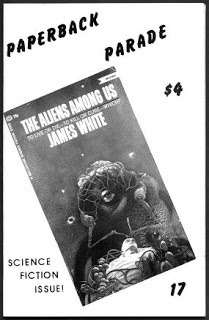 Anyhow, it took an entire year for my article/interview to actually get published in Paperback Parade, appearing in issue #17, March 1990. Also in that same issue is a lengthy retrospective article by Gary Lovisi on the various paperback editions of Vance's The Dying Earth. Vance wrote a series of stories during the '50s while in the Merchant Marines, and those stories were pulled together to form The Dying Earth, which was first published by Hillman Periodicals, New York, in 1950. Gryphon Books (not to be confused with Golden Gryphon Press), the publisher of Paperback Parade, still has copies of issue #17 available (though a second printing, priced at $10.00), and it appears that the periodical is still going strong, with issue #72 mentioned in the "News" column.
Anyhow, it took an entire year for my article/interview to actually get published in Paperback Parade, appearing in issue #17, March 1990. Also in that same issue is a lengthy retrospective article by Gary Lovisi on the various paperback editions of Vance's The Dying Earth. Vance wrote a series of stories during the '50s while in the Merchant Marines, and those stories were pulled together to form The Dying Earth, which was first published by Hillman Periodicals, New York, in 1950. Gryphon Books (not to be confused with Golden Gryphon Press), the publisher of Paperback Parade, still has copies of issue #17 available (though a second printing, priced at $10.00), and it appears that the periodical is still going strong, with issue #72 mentioned in the "News" column.
Of course, after our April 15 visit, I followed up with another letter, thanking Jack and Norma for their kindness and hospitality. I received a response once again from Jack, this one dated April 20, in which he notes: "I will be at a bookstore, the Dark Carnival, in Berkeley for activities I ordinarily do my best to avoid: namely a book-signing between 2 and 4 pm April 30." He then invited me back to the house : "should you chance to be in the neighborhood at 5:30 pm -- I stipulate time, so as not to interfere with my work-habits," and he concluded with: "thank you for your kind words." Again, the large, bold Jack Vance signature in black marker.
Forward in time to March 1990: Shortly after PP #17 was published, my comp copies arrived in the mail, along with extra copies for Michael Tallan and Jack Vance. Road trip! Granted, I could have mailed the copy of the 'zine to Jack Vance, but what fun was there in that? So I contacted Michael to make sure he was up for another trip to the Vances, and then I wrote Jack Vance once more, explaining that the interview had finally been published and that I would like to personally present him with a copy of the fanzine. This time, however, I received a very kind response from Norma Vance, dated March 8, 1990. She began the letter with: "We look forward to seeing the fanzine and your article," and suggested that if it wasn't too short a notice, that I come that weekend, either Saturday the 10th or Sunday the 11th. I don't recall the date that we actually visited, but I'll assume it was that weekend. By this time Jack had lost most of his eyesight (thus the letter from Norma, and not Jack himself) following his glaucoma surgery the previous July (approximately 3 months after our first visit). Consequently Norma was always at Jack's side from then on to assist him with signing his autograph: she would help place his left hand, and specifically his thumb, on the page to be signed where his signature was to begin; Jack would then use his thumb as a guide to begin writing the capital letter "J" -- and the rest of his signature would then flow naturally across the page. By the time he was done signing, his left thumb, and often his left index finger, was covered in black marker ink. Regardless, Jack Vance never disappointed his fans whenever he made an appearance, though these appearances became extremely rare in the years immediately following.
I actually recall even less about this second visit than I do the first, most likely because I didn't write about it at the time. But I did get my copy of PP #17 signed, and if I recall correctly, Michael brought along yet another boxful of books. Besides, how could we not enjoy sharing yet another house visit with the Vances.

What makes Jack Vance's writing so seductive is the rich texture of his words, the exotic rhythms of his sentences, and all the subtle nuances that make up a story of his creation. And his character names... it is as if the stories had to be written around the names; the stories had to exist because the names existed. Does that make sense? For example, the names of the five villains in the Demon Princes series: Attel Malagate (book 1), Kokor Hekkus (2), Viole Falushe (3), Lens Larque (4), and Howard Alan Treesong (5).
Earlier, I mentioned Vance's last novel, Lurulu . The title word is an undefined something, that the various characters in the story search for. Much of the story takes place aboard an intersteller freighter called the Glicca, captained by Adair Maloof. The ship travels from planet to planet, where adventures -- and misadventures -- occur. Captain Maloof, in an attempt to explain lurulu, calls it "a special word from the language of myth. It is much a mystery to me now as when I first yearned for something which seemed forever lost. But one day I shall glance over my shoulder, and there it will be, wondering why I had not come sooner."
. The title word is an undefined something, that the various characters in the story search for. Much of the story takes place aboard an intersteller freighter called the Glicca, captained by Adair Maloof. The ship travels from planet to planet, where adventures -- and misadventures -- occur. Captain Maloof, in an attempt to explain lurulu, calls it "a special word from the language of myth. It is much a mystery to me now as when I first yearned for something which seemed forever lost. But one day I shall glance over my shoulder, and there it will be, wondering why I had not come sooner."
--------------
Notes and Footnotes
The Jack Vance photo that opens this essay accompanied the New York Times article by Carlo Rotella; the photo was taken by Justin Stephens. Since I do not have the rights to reprint this photo, I have linked to the photo on the NYT website. It's an absolutely wonderful photograph of Jack Vance -- the man has traveled, the man has seen things. Thank you, Justin Stephens, for sharing this photograph with us.
And this is as good a time as any to thank my friend Michael Tallan for transporatation to and from the Vances' home -- twice. And for many more trips into the city for author readings and signings, and bookstore shopping.
1 I was saddened to read in the May 2008 issue of Locus magazine of the passing of Norma Vance. She was certainly a lovely, kind woman, always seeming to want to take care of us during our visits. And very protective of Jack, too. Born Norma Genvieve Ingold, on May 29, 1927; she passed away on March 25, 2008.
2 Though I didn't think to take photographs of the Vance house, I'm pleased to say that others did. Gan Uesli Starling evidently visited the Vances on January 21, 2000, according to his website, and took a number of photographs during his visit. Fortunately, Gan has posted an account of his visit, along with the photographs, in which you can see the dining room table at which we sat, surrounded by the three walls of windows. There is even one solo photo of just the ceiling tiles!
3 Go ahead, admit it: we all search for our own name on the net! Now, you can even set up a Google Alert to automate the process!
Addendum:
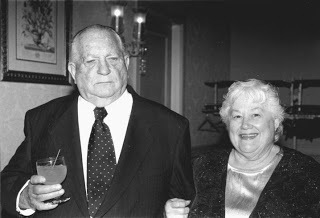
About five hours after I posted this blog entry, I received an email from Francesca Myman, editorial assistant at Locus magazine, in which the above photograph was attached. I had requested this photograph earlier in the week for use on the blog; I especially wanted a photo of Norma Vance. But when Francesca responded yesterday, she explained that the Locus office was extremely hectic. With the passing of Charles Brown on July 12, I could certainly understand the situation, and so I told her not to worry about the photo, that I would find one of Jack Vance on the net to use. So, my surprise when the above photo arrived. This is a wonderful picture of Jack and Norma Vance, from 1997, and taken by Charles N. Brown. A special "thank you" to Francesca and Locus magazine for allowing me to post the photo here. Charles Brown was the glue, if you will, that held together the worldwide SF community, and his passing has surely left a huge gap in that community. My sincere condolences to the staff of Locus, and Charles's family and friends.

In memory of Jack Vance, I would like to post the following, which I originally published on this blog on July 31, 2009: I recount my two visits to the Vance household in the Oakland foothills, in 1989 and 1990; I also hold Jack Vance responsible for my book collecting addiction....
At Home with Jack Vance
 At 92 years of age (soon to be 93, on August 28), author Jack Vance is finally garnering some long-overdue, well-deserved attention in the media. And considering that he hasn't published any new fiction since 2004 (novel Lurulu, sequel to Ports of Call, 1998; both from Tor Books), this is indeed a remarkable accomplishment. Why all the media attention now? Because Vance has two books that have just been published by Subterranean Press. First and foremost is Vance's autobiography,
This Is Me, Jack Vance!
At 92 years of age (soon to be 93, on August 28), author Jack Vance is finally garnering some long-overdue, well-deserved attention in the media. And considering that he hasn't published any new fiction since 2004 (novel Lurulu, sequel to Ports of Call, 1998; both from Tor Books), this is indeed a remarkable accomplishment. Why all the media attention now? Because Vance has two books that have just been published by Subterranean Press. First and foremost is Vance's autobiography,
This Is Me, Jack Vance!
 (more on this in a bit). The second title is anthology
Songs of the Dying Earth
(more on this in a bit). The second title is anthology
Songs of the Dying Earth
 , which is subtitled "Stories in Honor of Jack Vance." Songs features some of the best writers in the genre: Neil Gaiman, George R. R. Martin (who co-edited the anthology), Lucius Shepard, and Dan Simmons, to name only four, with an appreciation by Dean Koontz. What makes this book even more special is that Vance himself has written a new preface to open the anthology.
, which is subtitled "Stories in Honor of Jack Vance." Songs features some of the best writers in the genre: Neil Gaiman, George R. R. Martin (who co-edited the anthology), Lucius Shepard, and Dan Simmons, to name only four, with an appreciation by Dean Koontz. What makes this book even more special is that Vance himself has written a new preface to open the anthology.Carlo Rotella, director of American Studies at Boston College, wrote an excellent and lengthy piece (nearly 3,700 words) on Jack Vance entitled "The Genre Artist" in the July 15 New York Times. Rotella's introduction to Vance's fiction occurred when he was 14 years old, and he's been reading the author's work ever since. In this article Rotella quotes from a number of Vance novels, quotes from contributors (Tanith Lee and Dan Simmons) to the Songs anthology, and even quotes from Pulitzer Prize-winning novelist Michael Chabon: "Jack Vance is the most painful case of all the writers I love who I feel don't get the credit they deserve. If 'The Last Castle' or 'The Dragon Masters' had the name Italo Calvino on it, or just a foreign name, it would be received as a profound meditation, but because he's Jack Vance and published in Amazing Whatever, there's this insurmountable barrier." Well said, Mr. Chabon! I'm awaiting my copy of This Is Me, Jack Vance! from Subterranean Press, but in the meantime I have Rotella's article to tide me over. By the way, Rotella notes that "Vance takes pride in his craft but does not care to talk about it in any detail, going so far in his memoir as to consign almost all discussion of writing to a brief chapter at the end." If you're not familiar with Jack Vance, this article is a great mini-introduction to Vance's work, and his life. Kudos to Carlo Rotella.
I personally lay all the blame for my rampant book collecting on Jack Vance... Well, that's not really fair: his mass market paperback publishers Berkley Medallion and DAW Books actually share that dubious honor. I was already an avid book reader, but it was Jack Vance's Demon Princes series that drove me to my bibliophilic behavior. I don't recall how the Demon Princes series was brought to my attention, but in the early '80s I made a concerted effort to track down these five books. Now, you have to remember that at that point in time, there was no internet; there was no "online" in which to do an online book search. In those days we actually had to visit bookstores; and we used the telephone and, dare I say it, book catalogs sent through the mail to acquire specific titles. My favorite bookstore was Books, Inc. in the Town & Country shopping center near the corner of Stevens Creek and Winchester boulevards in San Jose. Books, Inc. closed down not too long after the Barnes and Noble superstore opened about a block away; and now the entire Town & Country shopping center is gone, replaced by the upscale Santana Row. But back to Books, Inc.: The store was a panacea for SF readers in particular because the management never returned a book. Regardless of the number of copies they ordered of any particular paperback, those copies would remain on the shelves until they sold. You could find paperbacks on the shelves that were years old, the pages often yellowed from age. So that's where I went to purchase the five volumes in Vance's Demon Princes series. The first three books in the series -- Star King, The Killing Machine, and The Palace of Love -- were published in the '60s by Berkley Medallion; the final two books in the series -- The Face and The Book of Dreams -- were published by DAW Books in 1979 and 1981 respectively. Unfortunately, I only found one of the DAW books on the shelf. A clerk assisted me by looking up the other four titles in Books in Print (available as a set of humongous hardcovers as well as on microfiche). It turned out that two of the five titles were out of print -- one from Berkley Medallion and the first book from DAW. And, not understanding the stupidity of publishers at the time, I couldn't comprehend why any publisher would allow the middle books of a five-book series to go out of print. It just didn't make any sense to me -- then. But in the course of looking through Books in Print, the clerk discovered that the series had been published in a hardcover edition by an independent press called Underwood-Miller. Great, I said, let's order them. Sorry, said the clerk, we don't deal directly with that publisher, and those titles aren't available through our regular distributor. Sigh... Time to go home and make some telephone calls to other bookstores in the area.
This is how I discovered genre bookstore Future Fantasy in Palo Alto, about a 25-mile drive from where I live. I telephoned the store, and yes, they could order the books for me, but I would have to pay for them in advance. So I made the drive to Palo Alto, only to discover that the store proprietor would only order one volume at a time -- even though I was willing to pay for the five books all at once, up front. Not sure of her rationale; but keep in mind that this was the early '80s and each of these trade hardcovers cost, I believe it was, $20.00 each -- so the set of five books was $100.00 (plus tax). Anyhow, I paid for the first book in advance, returned to the store a couple weeks later when the book arrived and paid in advance for the next one in the series, and so on until I owned all five books. Of course, I was now hooked on hardcovers and limited editions, having been in Future Fantasy -- browsing and buying -- six times over the span of about three months: the road to ruin, you might say. Future Fantasy moved a few years later to a larger store, but then the local competition and the internet finally took its toll and the store closed as well.

The Berkley Medallion paperbacks

The DAW paperbacks
However, I eventually did track down all five original mass market paperbacks of the Demon Princes series (see above book covers); and to accomplish that, I had to get on the catalog mailing lists for several dealers in collectible paperbacks. But that's another story. Which brings me to the fact that when I visited Jack and Norma Vance at their home in Oakland in 1989, Jack was gracious enough to sign these five paperbacks, and a few others for me as well. Now, about that visit --
I tracked down Jack Vance's address -- it may have been through a copy of Who's Who, but I can't really recall any longer. I wrote him a letter, introduced myself, complimented him on his work -- essentially, I'll admit it, I wrote a fan letter. But within that letter I also asked Jack if he would be willing to answer [in person] a few questions on his work for a fanzine that I wrote for: Paperback Parade. That initial letter of mine was written on an old Apple computer, and though I still have the computer in storage, all the media are long gone. However, I do have Jack's response: a brief, printed letter in a very large font bearing his bold, black-marker signature; unfortunately, I no longer have the envelope the letter came in, and the letter itself is undated, but I would estimate the time frame to be around March 1989. Jack wrote: "Yes, give me a call two or three days before you want to come up. One day is much like another around here, but call first anyway. Any time in the morning will suit, or, if better for you, 2 or 3 in the afternoon. Bring your friend, by all means, and your books -- but, sorry to say, I won't have time for an extended visit."
The "friend" to whom Jack refers is a long-time friend of mine, Michael Tallan, a book collector and bookseller here in San Jose. Michael and I spent many a day together in years (and years) past, hitting the bookstores in San Francisco and Berkeley; attending author readings and book signings; hanging out together at conventions. On each of the two visits to Jack Vance, Michael drove and I navigated. Where I had maybe a handful of books for Jack to sign, Michael had brought a boxful. In fact, during that first visit, Michael had brought a copy of the Summer 1945 issue of Thrilling Wonder Stories, which contained Jack Vance's first published story: "The World-Thinkers." Ah, but I'm getting ahead of myself.
Remember, this was 20 years ago, and much of the detail of that visit has been lost in the far recesses of ye olde memory. So please forgive me: I've plagiarized the description of the Vance home and the events of the day from my own (albeit brief) article in Paperback Parade. I wrote that piece when the day was vivid in my mind, and there is no way that, 20 years later, I could duplicate as effectively the words I wrote then.
On April 15, 1989, Michael and I made the drive to the Vance home. It was a typical warm, sunny Northern California afternoon, and a wonderful day to go visiting. Jack provided us with excellent directions from Berkeley -- Ashby Avenue, past the Berkeley Claremont Hotel, and onto the Warren Freeway. The Vance home, in the Oakland foothills, is atop a steep, long, gravel driveway. Michael parked at the bottom, off the main road, and we walked up the hill. Jack's son, John, met us out in front of the house and escorted us inside.
The Vances have a three-story hillside home. One walks up a flight of stairs, from the ground level, into the living quarters. Jack informed us that he purchased this land (and the "shack" that existed on it) in the '50s after completing a stint with the Merchant Marines. Over the years, he built up the property, initially by himself and then later with the help of John, to create the existing marvel.
Mrs. Vance -- Norma1 -- greeted Michael and me and then led us to the dining area where we sat and awaited Jack. Three sides of this room had oddly shaped glass windows, the fourth side was a small balcony that looked out over the kitchen below!
To my surprise, I learned that Jack is an avid potter and has a workshop downstairs. After joining us at the table, his hands still covered with the white of dried clay, he explained that he recently purchased a computer program on mixing glazes, but had had some difficulty with the software due to the flurry of computerese throughout the documentation. Jack even showed us the program manual in order to make his point. He then explained that he had telephoned the program's authors for some assistance and was now able to use the software.
Jack gave us a bit of a tour of the house, with special emphasis on the living room. The ceiling was comprised of imported, hand-tooled wooden tiles, each measuring approximately two-feet-square. Jack was obviously very proud of this ceiling; he spoke of the wood used to make the tiles and the woodworking -- I only wish I could remember from where (Pacific island?) he had imported the tiles.2 (Note: I suspect I'll learn all about the house -- and the tiles -- again, once I read the Vance autobiography.)
For the next two hours, Jack, Michael, and I chatted around the dining room table, munching mixed nuts from a large bowl that Norma had provided us. We discussed many of Jack's written works, past and present, and his future plans. Michael and I eagerly kept a constant flow of books in front of Jack until all were autographed. Due to Jack's limited eyesight, he uses a bold marker to sign books, his signature filling the page from margin to margin. I took a few photographs of Jack autographing our books but, since I chose not to impose upon him with the use of a flash, all the pictures unfortunately came out a bit too dark to reprint here, though a couple of the photos do appear alongside the interview in Paperback Parade. In retrospect, I'm now sorry that I didn't snap a picture or two of the Vance house.
Before our visit came to an end, I made sure that I had asked Jack the four questions that Gary Lovisi, editor and publisher of Paperback Parade, had provided me. Jack was opposed to my recording our conversation, however he did suggest that I take notes instead -- which I did. And since my note-taking was fast and furious, I was anxious to write up my notes as soon thereafter as possible.
Years later, I was searching for my own name on the net3, when I came across a website that was a resource of "Jack Vance Information." The owner of the site, Mike Berro, had catalogued every known book and story and nonfiction piece that Vance had written, as well as every known piece that was written about Vance -- including foreign editions as well. I was shocked to see my article from Paperback Parade included in this site's bibliography. I contacted Mike via email to express my surprise, and thus learned that a Vance interview -- even one as brief as mine -- was extremely rare, and therefore noteworthy. We exchanged a few emails (from which Mike quoted on the site) and then I gave him permission to reprint the entire article/mini-interview online. Earlier this week I went searching for that site so that I could link to it in this blog post, but alas the site is no longer in existence. And then I remembered the Wayback Machine! The name actually comes from the 1960s Rocky and Bullwinkle Show, specifically Mr. Peabody's "Improbable History" segment in which he transported back in time to some historical period in the WABAC (pronounced "wayback") machine. Anyhow, the Wayback Machine to which I refer is part of the Internet Archives. If you know the specific URL from some past site, it's just possible that the Internet Archives has it archived. I couldn't recall Mike Berro's name initially, but I did some searching for the Jack Vance Information website, and finally found a broken link for a "mikeb" -- and that's when I remembered Mike Berro's name; I did a bit more searching, and finally snagged the entire URL. I then entered the full URL in the Wayback Machine, and found the site archived over a number of years; after some trial and error, I found the necessary pages. So, courtesy of the Internet Archives, you can read my communication with Mike Berro as well as the transcribed text of my article in Paperback Parade.
And speaking of the importance of that mini-interview with Jack Vance: In my search for Berro's original Jack Vance Information site, I came upon another website, the Vance Museum. Unfortunately, there aren't many resources on this site, other than an extensive two-part Jack Vance biography written by David B. Williams. I was again surprised to see an excerpt from my interview with Vance quoted in this bio: "There were a lot of influences and it would be most difficult to put names to all of them," he [Vance] told Marty Halpern. "Robert Louis Stevenson, for one. Golden Book magazine had a fantasy story each month, a wonderful magazine.... I loved the Oz books as a child too, but you’ll not see any of those influences in my work." This Williams biography of Jack Vance is astutely written and well worth the time to read.
 Anyhow, it took an entire year for my article/interview to actually get published in Paperback Parade, appearing in issue #17, March 1990. Also in that same issue is a lengthy retrospective article by Gary Lovisi on the various paperback editions of Vance's The Dying Earth. Vance wrote a series of stories during the '50s while in the Merchant Marines, and those stories were pulled together to form The Dying Earth, which was first published by Hillman Periodicals, New York, in 1950. Gryphon Books (not to be confused with Golden Gryphon Press), the publisher of Paperback Parade, still has copies of issue #17 available (though a second printing, priced at $10.00), and it appears that the periodical is still going strong, with issue #72 mentioned in the "News" column.
Anyhow, it took an entire year for my article/interview to actually get published in Paperback Parade, appearing in issue #17, March 1990. Also in that same issue is a lengthy retrospective article by Gary Lovisi on the various paperback editions of Vance's The Dying Earth. Vance wrote a series of stories during the '50s while in the Merchant Marines, and those stories were pulled together to form The Dying Earth, which was first published by Hillman Periodicals, New York, in 1950. Gryphon Books (not to be confused with Golden Gryphon Press), the publisher of Paperback Parade, still has copies of issue #17 available (though a second printing, priced at $10.00), and it appears that the periodical is still going strong, with issue #72 mentioned in the "News" column.Of course, after our April 15 visit, I followed up with another letter, thanking Jack and Norma for their kindness and hospitality. I received a response once again from Jack, this one dated April 20, in which he notes: "I will be at a bookstore, the Dark Carnival, in Berkeley for activities I ordinarily do my best to avoid: namely a book-signing between 2 and 4 pm April 30." He then invited me back to the house : "should you chance to be in the neighborhood at 5:30 pm -- I stipulate time, so as not to interfere with my work-habits," and he concluded with: "thank you for your kind words." Again, the large, bold Jack Vance signature in black marker.
Forward in time to March 1990: Shortly after PP #17 was published, my comp copies arrived in the mail, along with extra copies for Michael Tallan and Jack Vance. Road trip! Granted, I could have mailed the copy of the 'zine to Jack Vance, but what fun was there in that? So I contacted Michael to make sure he was up for another trip to the Vances, and then I wrote Jack Vance once more, explaining that the interview had finally been published and that I would like to personally present him with a copy of the fanzine. This time, however, I received a very kind response from Norma Vance, dated March 8, 1990. She began the letter with: "We look forward to seeing the fanzine and your article," and suggested that if it wasn't too short a notice, that I come that weekend, either Saturday the 10th or Sunday the 11th. I don't recall the date that we actually visited, but I'll assume it was that weekend. By this time Jack had lost most of his eyesight (thus the letter from Norma, and not Jack himself) following his glaucoma surgery the previous July (approximately 3 months after our first visit). Consequently Norma was always at Jack's side from then on to assist him with signing his autograph: she would help place his left hand, and specifically his thumb, on the page to be signed where his signature was to begin; Jack would then use his thumb as a guide to begin writing the capital letter "J" -- and the rest of his signature would then flow naturally across the page. By the time he was done signing, his left thumb, and often his left index finger, was covered in black marker ink. Regardless, Jack Vance never disappointed his fans whenever he made an appearance, though these appearances became extremely rare in the years immediately following.
I actually recall even less about this second visit than I do the first, most likely because I didn't write about it at the time. But I did get my copy of PP #17 signed, and if I recall correctly, Michael brought along yet another boxful of books. Besides, how could we not enjoy sharing yet another house visit with the Vances.

What makes Jack Vance's writing so seductive is the rich texture of his words, the exotic rhythms of his sentences, and all the subtle nuances that make up a story of his creation. And his character names... it is as if the stories had to be written around the names; the stories had to exist because the names existed. Does that make sense? For example, the names of the five villains in the Demon Princes series: Attel Malagate (book 1), Kokor Hekkus (2), Viole Falushe (3), Lens Larque (4), and Howard Alan Treesong (5).
Earlier, I mentioned Vance's last novel, Lurulu
 . The title word is an undefined something, that the various characters in the story search for. Much of the story takes place aboard an intersteller freighter called the Glicca, captained by Adair Maloof. The ship travels from planet to planet, where adventures -- and misadventures -- occur. Captain Maloof, in an attempt to explain lurulu, calls it "a special word from the language of myth. It is much a mystery to me now as when I first yearned for something which seemed forever lost. But one day I shall glance over my shoulder, and there it will be, wondering why I had not come sooner."
. The title word is an undefined something, that the various characters in the story search for. Much of the story takes place aboard an intersteller freighter called the Glicca, captained by Adair Maloof. The ship travels from planet to planet, where adventures -- and misadventures -- occur. Captain Maloof, in an attempt to explain lurulu, calls it "a special word from the language of myth. It is much a mystery to me now as when I first yearned for something which seemed forever lost. But one day I shall glance over my shoulder, and there it will be, wondering why I had not come sooner."--------------
Notes and Footnotes
The Jack Vance photo that opens this essay accompanied the New York Times article by Carlo Rotella; the photo was taken by Justin Stephens. Since I do not have the rights to reprint this photo, I have linked to the photo on the NYT website. It's an absolutely wonderful photograph of Jack Vance -- the man has traveled, the man has seen things. Thank you, Justin Stephens, for sharing this photograph with us.
And this is as good a time as any to thank my friend Michael Tallan for transporatation to and from the Vances' home -- twice. And for many more trips into the city for author readings and signings, and bookstore shopping.
1 I was saddened to read in the May 2008 issue of Locus magazine of the passing of Norma Vance. She was certainly a lovely, kind woman, always seeming to want to take care of us during our visits. And very protective of Jack, too. Born Norma Genvieve Ingold, on May 29, 1927; she passed away on March 25, 2008.
2 Though I didn't think to take photographs of the Vance house, I'm pleased to say that others did. Gan Uesli Starling evidently visited the Vances on January 21, 2000, according to his website, and took a number of photographs during his visit. Fortunately, Gan has posted an account of his visit, along with the photographs, in which you can see the dining room table at which we sat, surrounded by the three walls of windows. There is even one solo photo of just the ceiling tiles!
3 Go ahead, admit it: we all search for our own name on the net! Now, you can even set up a Google Alert to automate the process!
Addendum:

About five hours after I posted this blog entry, I received an email from Francesca Myman, editorial assistant at Locus magazine, in which the above photograph was attached. I had requested this photograph earlier in the week for use on the blog; I especially wanted a photo of Norma Vance. But when Francesca responded yesterday, she explained that the Locus office was extremely hectic. With the passing of Charles Brown on July 12, I could certainly understand the situation, and so I told her not to worry about the photo, that I would find one of Jack Vance on the net to use. So, my surprise when the above photo arrived. This is a wonderful picture of Jack and Norma Vance, from 1997, and taken by Charles N. Brown. A special "thank you" to Francesca and Locus magazine for allowing me to post the photo here. Charles Brown was the glue, if you will, that held together the worldwide SF community, and his passing has surely left a huge gap in that community. My sincere condolences to the staff of Locus, and Charles's family and friends.

Published on May 29, 2013 16:41
May 22, 2013
CrossMe Color app for Android Redux
As I've mentioned in two previous blog posts (here and here), I have a rather strong addiction to an Android game called CrossMe Color. It's sort of like Suduku, but with numbers and colors.
I have now completed all the puzzles through level 8, which is the "Shogun" or "Expert" level. The game has a level 9, but all the puzzles are random. By that I mean the puzzles are simply random patterns, squares, and colors. Once a puzzle is completed, a return to the main menu will automatically clear the puzzle and randomize the patterns, squares, and colors again. When I get desperate enough for a CrossMe Color fix, I will work a random puzzle, but I'm not particularly fond of them: I prefer a puzzle of an actual picture/object, which is saved when the puzzle is completed.
Of course, I can always delete any puzzle solution and re-solve the puzzle, but for now I want to retain the completed puzzles. I'm hoping that the CrossMe Color developers will have an update soon that adds a few new puzzles to the existing levels.
In the meantime, I wanted to share with you a few of the level 7 (Sensei/Advanced) and the level 8 puzzles and solutions; I enjoy discovering what those rows and columns of colored, numbered squares will form when I complete a puzzle.
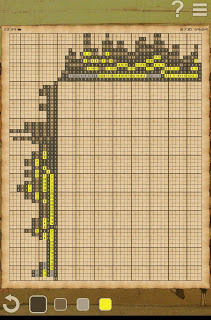
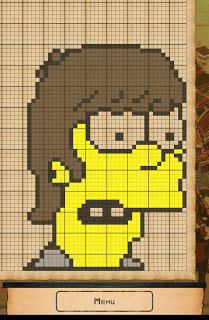
Puzzle 7.10 - Young Homer
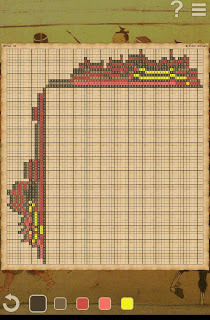
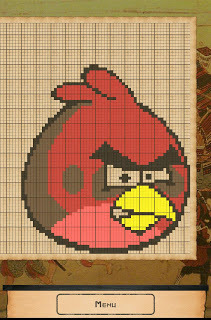
Puzzle 7-23 - Bird
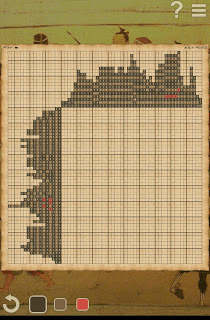
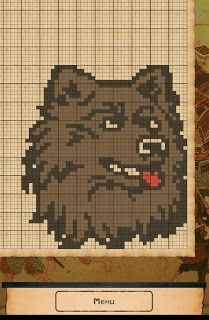
Puzzle 8-3 - Dog
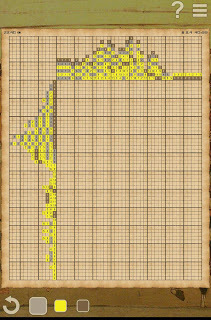
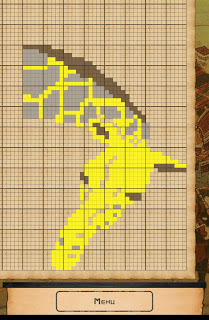
Puzzle 8.4 - Giraffe
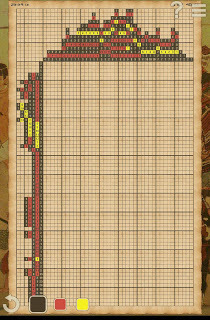
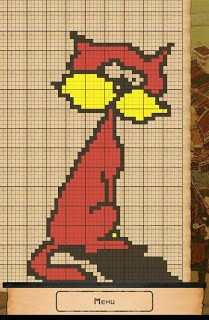
Puzzle 8.7 - Cat
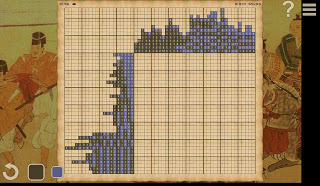
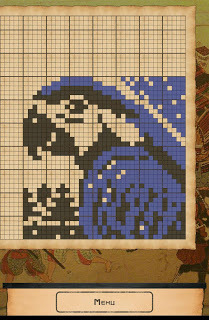
Puzzle 8.14 - Parrot
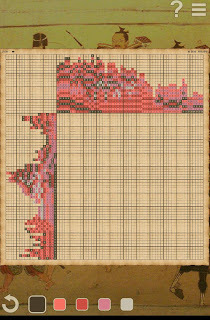
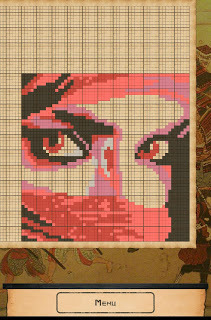
Puzzle 8.16 - East
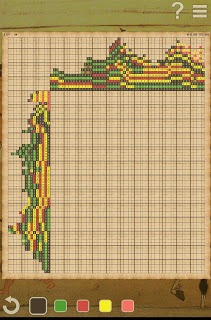
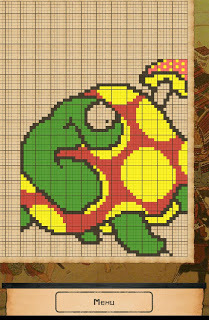
Puzzle 8.20 - Turtle
A few of the "expert" puzzles presented some difficulty, and I had to snag a few hints from the CrossMe Color Solutions Blog. But what I've pictured above are some of the puzzles that I solved completely on my own, and were personal favorites.
The CrossMe Color Premium app is $4.95 on both Google Play and the Amazon Appstore: a small amount for the hours (and hours) you'll find yourself engrossed in these puzzles.

I have now completed all the puzzles through level 8, which is the "Shogun" or "Expert" level. The game has a level 9, but all the puzzles are random. By that I mean the puzzles are simply random patterns, squares, and colors. Once a puzzle is completed, a return to the main menu will automatically clear the puzzle and randomize the patterns, squares, and colors again. When I get desperate enough for a CrossMe Color fix, I will work a random puzzle, but I'm not particularly fond of them: I prefer a puzzle of an actual picture/object, which is saved when the puzzle is completed.
Of course, I can always delete any puzzle solution and re-solve the puzzle, but for now I want to retain the completed puzzles. I'm hoping that the CrossMe Color developers will have an update soon that adds a few new puzzles to the existing levels.
In the meantime, I wanted to share with you a few of the level 7 (Sensei/Advanced) and the level 8 puzzles and solutions; I enjoy discovering what those rows and columns of colored, numbered squares will form when I complete a puzzle.


Puzzle 7.10 - Young Homer


Puzzle 7-23 - Bird


Puzzle 8-3 - Dog


Puzzle 8.4 - Giraffe


Puzzle 8.7 - Cat


Puzzle 8.14 - Parrot


Puzzle 8.16 - East


Puzzle 8.20 - Turtle
A few of the "expert" puzzles presented some difficulty, and I had to snag a few hints from the CrossMe Color Solutions Blog. But what I've pictured above are some of the puzzles that I solved completely on my own, and were personal favorites.
The CrossMe Color Premium app is $4.95 on both Google Play and the Amazon Appstore: a small amount for the hours (and hours) you'll find yourself engrossed in these puzzles.

Published on May 22, 2013 12:03
May 18, 2013
Jonathan Strahan's Year's Best Science Fiction and Fantasy 6
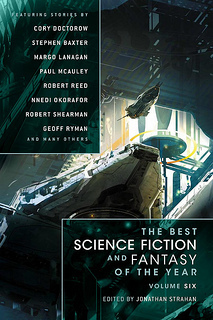 A couple weeks ago I published a blog post (Doin' Hard Time at Night Shade Books) on my nine years with Night Shade Books. In that post I listed the 125 books that I worked on throughout those nine years. One such book was Jonathan Strahan's annual anthology
The Best Science Fiction and Fantasy of the Year, Volume 6
A couple weeks ago I published a blog post (Doin' Hard Time at Night Shade Books) on my nine years with Night Shade Books. In that post I listed the 125 books that I worked on throughout those nine years. One such book was Jonathan Strahan's annual anthology
The Best Science Fiction and Fantasy of the Year, Volume 6
 .
.When I checked my email this morning, I found a note from Jonathan Strahan awaiting my perusal. In the email, which was also addressed to Ross E. Lockhart, Jonathan informed us that his book, The Best Science Fiction and Fantasy of the Year, Volume 6
 , had just won the Aurealis Award -- Australia's premier genre award -- for best anthology of the year, and that he wanted to thank Ross and me for our work on this, and his previous books.
, had just won the Aurealis Award -- Australia's premier genre award -- for best anthology of the year, and that he wanted to thank Ross and me for our work on this, and his previous books.Of course, receiving a "thank you" email from an award recipient for one's contribution is very cool. However, as I was catching up on my online reading (Google Reader feeds) I saw that Jonathan had also posted about his award win on his blog Notes from Coode Street. Included in his post was his acceptance speech, which had been read by James Bradley, in Jonathan's absence, at the awards ceremony. With Jonathan's most kind permission, here is his Aurealis Award acceptance speech in its entirety:
Thank you so much. If James Bradley is reading these words to you, which I promise I will keep brief as absent winners should, then it means my anthology The Best Science Fiction and Fantasy of the Year: Volume Six has won the Aurealis Award. It is a great honour and I wish I was there in the Independent Theatre in Sydney, and not sitting in Perth following this on Twitter, so that you all could see just how thrilled I am.
I would sincerely like to thank the judges Kathleen Stubbs, Matt Chrulew and Sarah Fletcher for their hard work (and commend them on their excellent taste), and I also want to thank awards administrator Tehani Wesley and the AA team for their hard work. It is an honour to be nominated alongside my editorial colleagues Liz Gryb, Talie Helene, and Amanda Pillar and the great team at my dear friend Russell Farr’s Ticonderoga, and I extend my congratulations to them as well.
Editing The Best Science Fiction and Fantasy of the Year series has defined the past seven years of my life. It’s a strange, wonderful experience, and I am deeply proud of the books I’ve been able to produce with the Night Shade team. I would especially like to thank Ross Lockhart and Marty Halpern at Night Shade Books for the care and attention they gave to this book, and for their work on the rest of the series. They are my unsung collaborators and deserve your congratulations as much as I do.
Finally, and most importantly, I would like to acknowledge the efforts of my spectacular agent Howard Morhaim, and the tireless support of my family Marianne, Jessica and Sophie who give me time to do this strange editing thing that I love doing so much.
Thank you all very much! Have a great night! I’m going to turn Twitter off now and go have a glass of champagne (or at least get the kids dinner on).
Like I said, receiving a thank you email for contributing to an award-winning book is one thing; having one's name mentioned in an acceptance speech takes that "thank you" to an entirely new level.
I, in turn, would like to thank Jonathan for the opportunity to work on his "best of the year" anthologies; I read many fine stories in these volumes that I wouldn't have had the occasion to read otherwise. And while I'm at it, let me thank Ross Lockhart, who kept the work flowing for the past five years at Night Shade Books. Ross could have sent Jonathan's anthologies to any number of other copy editors, but he typically sent the books to me.

Published on May 18, 2013 18:19



